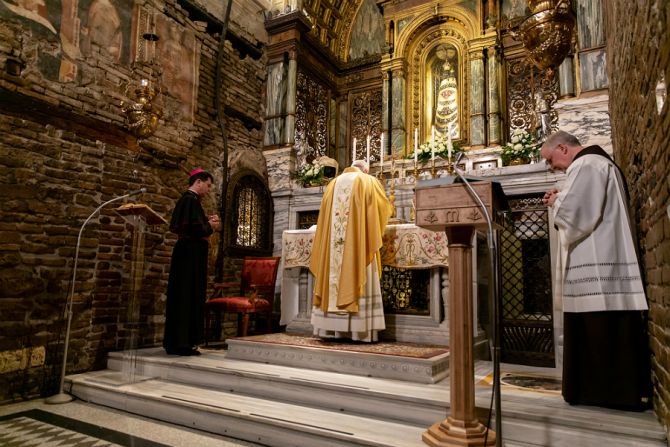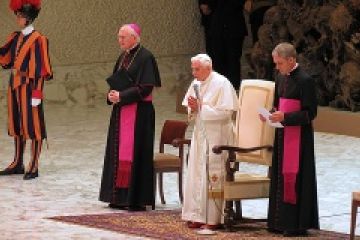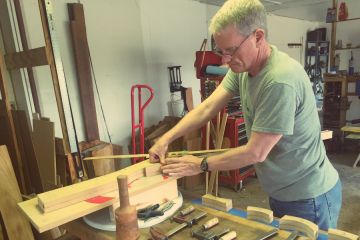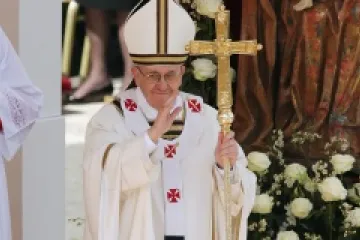Loreto, Italy, Mar 27, 2019 / 13:23 pm
The Vatican press office declined to comment after a video went viral this week showing the pope refusing to allow pilgrims to kiss his ring as they greeted him.
The clip was taken from video footage of pilgrims meeting the pope after his celebration of Mass in the Holy House in Loreto, Italy, March 25.
In the clip, which is just over a minute in length, Pope Francis appears to pull his hand away each time a person approaches to greet him and attempts to kneel and to kiss his hand or ring.
A more full video by Vatican Media showed that the pope was receiving people for much longer than the first clip presented – around 13 minutes in total – and that he had allowed some people to kiss his ring, without visible protest, during the earlier part of the greeting line.
The custom of kissing the ring of the pope or a bishop has been a gesture of respect in the Church for longer than can be remembered, but likely started in the late Middle Ages, according to Fr. Roberto Regoli, who teaches contemporary Church history at the Pontifical Gregorian University.
He said kissing the pope's ring "expresses devotion not to the person of the pope, but to whom and what he represents: the successor of the fisherman of Galilee" and "indicates fidelity and love for the Church."
While the commonly-used Italian term for the greeting is "baciamano," literally meaning "hand kiss," Regoli said that is misleading, and properly speaking, it is the papal Ring of the Fisherman which is kissed.
Pope Francis did not appear to be wearing that particular ring in Loreto March 25. Outside of papal ceremonies, Francis is typically seen wearing only his episcopal ring.
The custom of kissing the Fisherman's Ring, while it begun much earlier, was systematized in the 15th century in a text on pontifical ceremonies, Regoli said.
It is customary to kiss the ring of a bishop, out of reverence for his dignity as a successor of the apostles, and the hand of a priest, as it has been anointed with chrism to consecrate the Body of Christ.
The prayer traditionally said by a bishop before vesting with his ring for pontifical Mass is: "The digits of my heart and my body, O Lord, adorn with virtue, and with the sanctification of the sevenfold Spirit surround them."
The Fisherman's Ring is one of several rings typically worn by the Roman pontiff. The ring takes its name from its image of St. Peter as a fisherman, which became the standard design around the mid-15th century.
The first record of the ring's use was on two letters of Clement IV in 1265 and 1266. It was used as a wax seal in private letters in place of the official lead seal used for solemn papal documents.
In 1842, use of the ring and wax seal were replaced by a stamp, but each pope still receives a unique Ring of the Fisherman at the start of his papacy, which is then destroyed soon after his death.
In the early 20th century, St. Pius X connected a partial indulgence to kissing the Fisherman's Ring.
The custom started to change with St. Paul VI in the last decades of the 20th century, when he eliminated other forms of showing papal obedience and subservience, such as kissing the pope's foot, shoulder, and cheek, Regoli explained.
(Story continues below)
Fr. Johannes Grohe, a professor of Church history at the Pontifical University of the Holy Cross, told CNA that to greet a bishop with a kiss of his ring is a sign of his episcopal dignity and is still "quite widespread."
In the past, "this gesture was accompanied by a bow of the head or a knee bend," he said, and while "kissing the episcopal ring in an official greeting is still in use, to bend the knee not so much."
Pope Francis, he continued, "seems to be against it. Sometimes he allows it, sometimes he denies it (even in an apparent way)."
Regoli said that with Francis "there is a further sensibility, different from his predecessors, so we tend to further simplify the ceremonial by omitting the greeting of genuflection towards him."
According to Grohe, "there is in [Pope Francis] an attitude contrary to everything that could recall court customs," and "certainly," he added, "some customs in ceremonies and pontifical audiences have a long tradition and therefore also have the form of other time periods."






